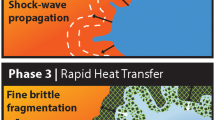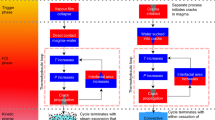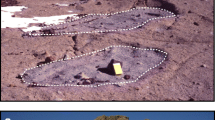Abstract
Physical analysis of explosive, magma-water interaction is complicated by several important controls: (1) the initial geometry and location of the contact between magma and water; (2) the process by which thermal energy is transferred from the magma to the water; (3) the degree to and manner by which the magma and water become intermingled prior to eruption; (4) the thermodynamic equation of state for mixtures of magma fragments and water; (5) the dynamic metastability of superheated water; and (6) the propagation of shock waves through the system. All of these controls can be analyzed while addressing aspects of tephra emplacement from the eruptive column by fallout, surge, and flow processes. An ideal thermodynamic treatment, in which the magma and external water are allowed to come to thermal equilibrium before explosive expansion, shows that the maximum system pressure and entropy are determined by the mass ratio of water and magma interacting. Explosive (thermodynamic) efficiency, measured by the ratio of maximum work potential to thermal energy of the magma, depends upon heat transfer from the pyroclasts to the vapor during the expansion stage. The adiabatic case, in which steam immediately separates from the tephra during ejection, produces lower efficiencies than does the isothermal case, in which heat is continually transferred from tephra to steam as it expands. Mechanisms by which thermal equilibrium between water and magma can be obtained require intimate mixing of the two. Interface instabilities of the Landau and Taylor type have been documented by experiments to cause fine-scale mixing prior to vapor explosion. In these cases, water is heated rapidly to a metastable state of superheat where vapor explosion occurs by spontaneous nucleation when a temperature limit is exceeded. Mixing may also be promoted by shock wave propagation. If the shock is of sufficient strength to break the magma into small pieces, thermal equilibrium and vapor production in its wake may drive the shock as a thermal detonation. Because these mechanisms of magma fragmentation allow calculation of grain size, vapor temperature and pressure, and pressure rise times, detailed emplacement models can be developed by critical field and laboratory analysis of the resulting tephra deposits. Deposits left by dense flows of tephra and wet steam as opposed to those left by dilute flows of dry steam and tephra show contrasts in median grain size, dispersal area, grain shape, grain surface chemistry, and bed form.
Similar content being viewed by others
References
Bankoff SG, Jo JH (1976) Existence of steady-state fuel-coolant thermal detonation waves. ERDA Rep NU-2512-6 (CONF-760328-8), Nat Tech Inform Ser Springfield, Virginia
Bellman R, Pennington RH (1954) Effects of surface tension and viscosity on Taylor instability. Quart Appl Math 12: 151–162
Bennett FD (1974) On volcanic ash formation. Am J Sci 274: 648–661
Berenson PJ (1961) Film boiling heat transfer from a horizontal surface. J Heat Transfer: 351–358
Berman M (1983) Light water reactor safety research program semiannual report, April – September 1982. Sandia Nat Labs SAND83-1576 NUREG/CR-3407, Nat Tech Inform Ser Springfield, Virginia
Berman M (1984) Light water reactor safety research program semiannual report, October 1982 – March 1983. Sandia Nat Labs SAND84-0688 NUREG/CR-3734, Nat Tech Inform Ser Springfield, Virginia
Board SJ, Hall RW, Hall RS (1975) Detonation of fuel coolant explosions. Nature 254: 319–321
Boivin P, Bourdier JL, Camus A, de Goer de Herve A, Gourgaud A, Kieffer G, Mergoil J, Vincent PM, Auby R (1982) Influence de la nature des magmas sur activité phreatomagmatique: approche volcanologique et thermodynamique. Bull Volcanol 45: 25–40
Burnham CW (1983) Deep submarine pyroclastic eruptions. Econ Geol Mono 5: 142–148
Burnham CW, Holloway JR, Davis NF (1969) Thermodynamic properties of water to 1000 °C and 10 000 bars. Geol Soc Am Sp Pap 132: 1–96
Buxton LD, Benedict WB (1979) Steam explosion efficiency studies. Sandia Nat Labs SAND79-1399 NUREG/CR-0947, Nat Tech Inform Ser Springfield, Virginia, pp 1–62
Carlisle D (1963) Pillow breccias and their aquagene tuffs, Quadra Island, British Columbia. Am J Sci 71: 48–71
Chandrasekhar S (1968) Hydrodynamic and hydromagnetic stability, 2nd edn. Oxford University Press, Oxford, pp 1–652
Condiff DW (1982) Contributions concerning quasi-steady propagation of thermal detonations through dispersions of hot liquid fuel in cooler volatile liquid coolants. Int J Heat Mass Transfer 25: 87–98
Corradini ML (1978) Heat transfer and fluid flow aspects of fuel-coolant interactions. PhD Thesis, Massachusetts Inst Tech, Cambridge Mass, USA
Corradini ML (1981a) Phenomenological modelling of the triggering phase of small-scale steam explosion experiments. Nucl Sci Eng 78: 154–170
Corradini ML (1981b) Analysis and modelling of steam explosion experiments. Sandia Nat Labs SAND80-2131 NUREG/CR-2072, Nat Tech Inform Ser Springfield, Virginia, pp 1–114
Courant R, Friedrichs KO (1948) Supersonic flow and shock waves. Springer, New York, pp 1–464
Cronenberg AW (1980) Recent developments in the understanding of energetic molten fuel-coolant interactions. Nucl Saf 21: 319–337
Crowe BM, Wohletz KH, Vaniman, DT, Gladney E (1985) Status of volcanic hazard studies for the Nevada nuclear waste storage investigations: part II--FY85. Los Alamos Nat Lab Rep LA-9325-MSII, Nat Tech Inform Ser Springfield, Virginia, pp 1–67
Delaney PT (1982) Rapid intrusion of magma into wet rock: ground water flow due to pore pressure increases. J Geophys Res 87: 7739–7756
De Rita D, Funiciello R, Rossi U, Sposato A (1983) Structure and evolution of the Sacrofano-Baccano caldera, Sabatini volcanic complex, Rome. J Volcanol Geotherm Res 17: 219–236
Drumheller DS (1979) The initiation of melt fragmentation in fuel-coolant interactions. Nucl Sci Eng 72: 347–356
Fauske HK (1973) On the mechanism of uranium dioxide-sodium explosive interactions. Nucl Sci Eng 51: 95–101
Fauske HK (1977) Some comments on shock-induced fragmentation and detonating thermal explosions. Am Nucl Soc Trans 27: 666–667
Fisher JC (1948) The fracture of liquids. J Appl Phys 19: 1062–1067
Fowles GR (1979) Vapor phase explosions: elementary detonations? Science 204: 168–169
Frazzetta G, La Volpe L, Sheridan M (1983) Evolution of the Fossa cone, Vulcano. J Volcanol Geotherm Res 17: 329–360
Frenkel J (1946) Kinetic theory of liquids. Clarendon, Oxford
Froehlich G, Mueller G, Unger H (1976) Experiments with water and hot melts of lead. J Non-Equil Thermodyn 1: 91–103
Froehlich G, Mueller G, Unger H (1978) Analysis of shapes of solidified melts from entrapment experiments. Am Nucl Soc Trans 28: 449
Funiciello R, Locardi E, Lombardi G, Parotto M (1976) The sedimentary ejecta from phreatomagmatic activity and their use for location of potential geothermal areas. In: Proceedings Geothermal Energy, International Congress on Thermal Waters, Geothermal Energy and Vulcanism of the Mediterranean Area, Athens, pp 227–240
Heiken GH (1971) Tuff rings: examples from the Fort Rock-Christmas Lake Valley basin, south-central Oregon. J Geophys Res 76: 5615–5626
Heiken GH (1972) Morphology and petrography of volcanic ashes. Geol Soc Am Bull 83: 1961–1988
Heiken GH (1974) An atlas of volcanic ash. Smithson Contrib Earth Sci 12: 1–101
Henry RE, Miyazaki K (1978) Effects of system pressure on the bubble growth from highly superheated water droplets. In: SG Bankoff (ed) Topics in two-phase heat transfer and flow, Am Soc Mech Eng New York, pp 1–10
Hicks EP, Menzies DC (1965) Theoretical studies on the fast reactor maximum accident. In: Proceedings of the Conference on Safety, Fuels, and Core Design in Large Fast Power Reactors, October 11–14, 1965, USAEC Rep ANL-7120, Nat Tech Inform Ser Springfield, Virginia, pp 654–670
Hildreth W, Christiansen RL, O'Neil JR (1984) Catastrophic isotopic modification of rhyolitic magma at times of caldera subsidence, Yellowstone Plateau volcanic field. J Geophys Res 89: 8339–8370
Holloway JR (1977) Fugacity and activity of molecular species in supercritical fluids. In: Fraser DG (ed) Thermodynamics in geology, Reidel Dordrecht-Holland, pp 161–181
Houghton BF, Hacket WR (1984) Strombolian and phreatomagmatic deposits of Ohakune craters, Ruapehu, New Zealand: a complex interaction between external water and rising basaltic magma. J Volcanol Geotherm Res 21: 207–231
Inman DL (1952) Measures for describing the size distribution of sediments. J Sediment Petrol 22: 125–145
Johnson SM (1971) Explosive excavation technology. US Army Eng Nucl Crat Group Rep 21, Nat Tech Inform Ser Springfield, Virginia, pp 229
Kieffer SW (1984) Seismicity at Old Faithful geyser: an isolated source of geothermal noise and possible analogue of volcanic seismicity. J Volcanol Geotherm Res 22: 59–95
Kieffer SW, Delany JM (1979) Isentropic decompression of fluids from crustal and mantle pressures. J Geophys Res 84: 1611–1620
Knapp RB, Knight JE (1977) Differential thermal expansion of pore fluids: fracture and microearthquake production in hot pluton environments. J Geophys Res 82: 2515–2522
Kokelaar BP (1982) Fluidization of wet sediments during the emplacement and cooling of various igneous bodies. J Geol Soc London 139: 21–33
Kokelaar BP (1983) The mechanism of Surtseyan volcanism. J Geol Soc London 140: 933–944
Ladisch R (1977) Comment on fragmentation of UO by thermal stress and pressurization. Nucl Eng Des 43: 327–328
Landau LD, Lifshitz BM (1959) Fluid mechanics: vol 6, Course of theoretical physics. Pergamon, New York
Lipman PW, Friedman I (1975) Interaction of meteoric water with magma: an oxygen isotope study of ash-flow sheets from southern Nevada. Geol Soc Am Bull 86: 695–702
McNutt S (1985) Volcanic tremor: basic facts and perspective. EOS Trans Am Geophys Union 66(46): 1152
Moore JG, Nakamura K, Alcaraz A (1966) The 1965 eruption of Taal Volcano. Science 151: 955–960
Nelson LS, Duda PM (1981) Steam explosion experiments with single drops of CO2 laser-melted iron oxide. Am Nocl Soc Trans 38: 453–454
Oh M-D (1985) Thermal-hydraulic modelling and analysis for large-scale vapor explosions. Univ Wisconsin Reac Saf Res Thesis 29: 1–395
Patel PD, Theofanous TG (1978) Fragmentation requirements for detonating thermal explosions. Nature 274: 142–144
Pike RJ, Clow GD (1981) Revised classification of terrestrial volcanoes and catalog of topographic dimensions, with new results on edifice volume. US Geol Surv Open File Rep 81-1038: 1–140
Rabie RL, Fowles GR, Fickett W (1979) The polymorphic detonation. Phys Fluids 22: 422–435
Reid RC (1976) Superheated liquids. Am Sci 64: 146–156
Rez P, Konopka J (1984) Limitations in the use of the peak-to-background method for quantitative analysis. X-ray Spect 13: 33–37
Self S (1983) Large-scale phreatomagmatic silicic volcanism: a case study from New Zealand. J Volcanol Geotherm Res 17: 433–469
Self S, Wilson L, Nairn IA (1979) Vulcanian eruption mechanisms. Nature 277: 440–443
Self S, Kienle J, Hoot JP (1980) Ukinrek maars, Alaska, II. deposits and formation of the 1977 craters. J Volcanol Geotherm Res 7: 39–65
Sharon A, Bankoff SG (1981) On the existence of steady supercritical plane thermal detonations. Int J Mass Heat 24: 1561–1572
Shepherd JE, Sturtevant B (1982) Rapid evaporation at the superheat limit. J Fluid Mech 121: 379–402
Sheridan MF, Barberi F, Rosi M, Santacroce R (1981) A model for Plinian eruptions of Vesuvius. Nature 22: 282–285
Sheridan MF, Marshall JR (1983) SEM examination of pyroclastic materials: basic considerations. In: Scanning Electron Microscopy 1983. SEM, Chicago, pp 113–118
Sheridan ME, Wohletz KH (1981) Hydrovolcanic explosions: the systematics of water-pyroclast equilibration. Science 212: 1387–1389
Sheridan MF, Wohletz KH (1983) Hydrovolcanism: basic considerations and review. J Volcanol Geotherm Res 17: 1–29
Sourirajan S, Kennedy GC (1962) The system H2O-NaCl at elevated temperatures and pressures. Am J Sci 260: 115–141
Sturtevant B, Frost D (1984) Effects of ambient pressure on the instability of a liquid boiling explosively at the superheat limit. In: Proceedings of the Symposium on Fundamentals of Phase Change: Boiling and Condensation, Am Soc Mech Eng Winter Annual Meeting 1984
Taylor HP (1971) Oxygen isotope evidence for large-scale interaction between meteoric ground waters and Tertiary granodiorite intrusions, western Cascade range, Oregon. J Geophys Res 76: 7855–7874
Thorarinsson S, Einarsson T, Sigvaldason G, Elisson G (1964) The submarine eruption off the Vestmann Islands 1963–64. A preliminary report. Bull Volcanol 27: 437–446
Vaniman D, Crowe BM (1981)Geology and petrology of the basalts of crater flat: applications to volcanic risk assessment for the Nevada nuclear waste storage investigations. Los Alamos Natl Lab Rep LA-8845-MS, Nat Tech Inform Ser Springfield, Virginia, pp 1–267
Verbeek RDM (1885) Krakatau. Batavia, pp 1–495
Walker GPL, Croasdale R (1971) Characteristics of some basaltic pyroclastics. Bull Volcanol 35: 305–317
Waters AC, Fisher RV (1971) Base surges and their deposits: Capelinhos and Taal Volcanoes. J Geophys Res 76: 5596–5614
Williams H, McBirney AR (1979) Volcanology. Freeman, San Francisco, pp 1–391
Wohletz KH (1983a) Mechanisms of hydrovolcanic pyroclast formation: grain-size, scanning electron microscopy, and experimental results. J Volcanol Geotherm Res 17: 31–63
Wohletz KH (1983b) Chemical and textural surface features of pyroclasts from hydromagmatic eruption sequences. In: Marshall JR (ed) Characterization and quantification of surface features on Clastic and Pyroclastic particles. Hutchinson, San Francisco and Los Alamos Nat Lab LA-UR 83-250, Los Alamos, New Mexico
Wohletz KH, McQueen RG (1984) Experimental studies of hydromagmatic volcanism. In: Explosive volcanism: inception, evolution, and hazards. Studies in Geophysics. National Academy Press, Washington, pp 158–169
Womer MB, Greeley R, King JS (1980) The geology of Split Butte - a maar of the south-central Snake River plain, Idaho. Bull Volcanol 43: 453–472
Author information
Authors and Affiliations
Rights and permissions
About this article
Cite this article
Wohletz, K.H. Explosive magma-water interactions: Thermodynamics, explosion mechanisms, and field studies. Bull Volcanol 48, 245–264 (1986). https://doi.org/10.1007/BF01081754
Received:
Accepted:
Issue Date:
DOI: https://doi.org/10.1007/BF01081754




